Vasilii Feofanov
Leveraging Generic Time Series Foundation Models for EEG Classification
Oct 31, 2025Abstract:Foundation models for time series are emerging as powerful general-purpose backbones, yet their potential for domain-specific biomedical signals such as electroencephalography (EEG) remains rather unexplored. In this work, we investigate the applicability a recently proposed time series classification foundation model, to a different EEG tasks such as motor imagery classification and sleep stage prediction. We test two pretraining regimes: (a) pretraining on heterogeneous real-world time series from multiple domains, and (b) pretraining on purely synthetic data. We find that both variants yield strong performance, consistently outperforming EEGNet, a widely used convolutional baseline, and CBraMod, the most recent EEG-specific foundation model. These results suggest that generalist time series foundation models, even when pretrained on data of non-neural origin or on synthetic signals, can transfer effectively to EEG. Our findings highlight the promise of leveraging cross-domain pretrained models for brain signal analysis, suggesting that EEG may benefit from advances in the broader time series literature.
Time Series Representations for Classification Lie Hidden in Pretrained Vision Transformers
Jun 10, 2025Abstract:Time series classification is a fundamental task in healthcare and industry, yet the development of time series foundation models (TSFMs) remains limited by the scarcity of publicly available time series datasets. In this work, we propose Time Vision Transformer (TiViT), a framework that converts time series into images to leverage the representational power of frozen Vision Transformers (ViTs) pretrained on large-scale image datasets. First, we theoretically motivate our approach by analyzing the 2D patching of ViTs for time series, showing that it can increase the number of label-relevant tokens and reduce the sample complexity. Second, we empirically demonstrate that TiViT achieves state-of-the-art performance on standard time series classification benchmarks by utilizing the hidden representations of large OpenCLIP models. We explore the structure of TiViT representations and find that intermediate layers with high intrinsic dimension are the most effective for time series classification. Finally, we assess the alignment between TiViT and TSFM representation spaces and identify a strong complementarity, with further performance gains achieved by combining their features. Our findings reveal yet another direction for reusing vision representations in a non-visual domain.
Mantis: Lightweight Calibrated Foundation Model for User-Friendly Time Series Classification
Feb 21, 2025Abstract:In recent years, there has been increasing interest in developing foundation models for time series data that can generalize across diverse downstream tasks. While numerous forecasting-oriented foundation models have been introduced, there is a notable scarcity of models tailored for time series classification. To address this gap, we present Mantis, a new open-source foundation model for time series classification based on the Vision Transformer (ViT) architecture that has been pre-trained using a contrastive learning approach. Our experimental results show that Mantis outperforms existing foundation models both when the backbone is frozen and when fine-tuned, while achieving the lowest calibration error. In addition, we propose several adapters to handle the multivariate setting, reducing memory requirements and modeling channel interdependence.
Measuring Pre-training Data Quality without Labels for Time Series Foundation Models
Dec 09, 2024Abstract:Recently, there has been a growing interest in time series foundation models that generalize across different downstream tasks. A key to strong foundation models is a diverse pre-training dataset, which is particularly challenging to collect for time series classification. In this work, we explore the performance of a contrastive-learning-based foundation model as a function of the data used for pre-training. We introduce contrastive accuracy, a new measure to evaluate the quality of the representation space learned by the foundation model. Our experiments reveal the positive correlation between the proposed measure and the accuracy of the model on a collection of downstream tasks. This suggests that the contrastive accuracy can serve as a criterion to search for time series datasets that can enhance the pre-training and improve thereby the foundation model's generalization.
Analysing Multi-Task Regression via Random Matrix Theory with Application to Time Series Forecasting
Jun 14, 2024
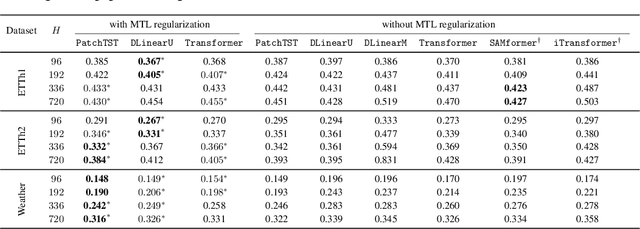
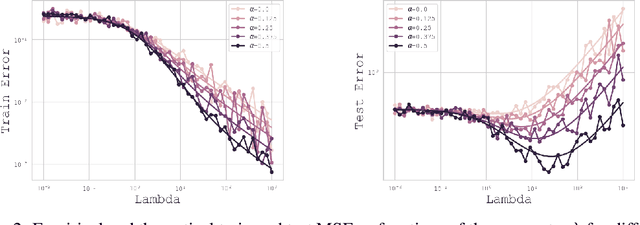
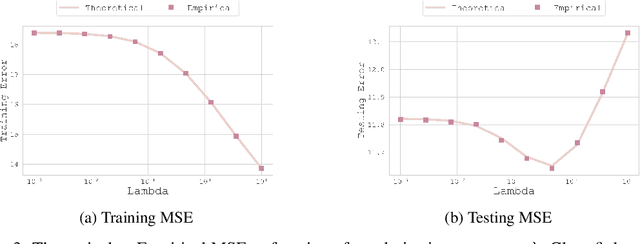
Abstract:In this paper, we introduce a novel theoretical framework for multi-task regression, applying random matrix theory to provide precise performance estimations, under high-dimensional, non-Gaussian data distributions. We formulate a multi-task optimization problem as a regularization technique to enable single-task models to leverage multi-task learning information. We derive a closed-form solution for multi-task optimization in the context of linear models. Our analysis provides valuable insights by linking the multi-task learning performance to various model statistics such as raw data covariances, signal-generating hyperplanes, noise levels, as well as the size and number of datasets. We finally propose a consistent estimation of training and testing errors, thereby offering a robust foundation for hyperparameter optimization in multi-task regression scenarios. Experimental validations on both synthetic and real-world datasets in regression and multivariate time series forecasting demonstrate improvements on univariate models, incorporating our method into the training loss and thus leveraging multivariate information.
MANO: Exploiting Matrix Norm for Unsupervised Accuracy Estimation Under Distribution Shifts
May 29, 2024



Abstract:Leveraging the models' outputs, specifically the logits, is a common approach to estimating the test accuracy of a pre-trained neural network on out-of-distribution (OOD) samples without requiring access to the corresponding ground truth labels. Despite their ease of implementation and computational efficiency, current logit-based methods are vulnerable to overconfidence issues, leading to prediction bias, especially under the natural shift. In this work, we first study the relationship between logits and generalization performance from the view of low-density separation assumption. Our findings motivate our proposed method MaNo which (1) applies a data-dependent normalization on the logits to reduce prediction bias, and (2) takes the $L_p$ norm of the matrix of normalized logits as the estimation score. Our theoretical analysis highlights the connection between the provided score and the model's uncertainty. We conduct an extensive empirical study on common unsupervised accuracy estimation benchmarks and demonstrate that MaNo achieves state-of-the-art performance across various architectures in the presence of synthetic, natural, or subpopulation shifts.
Unlocking the Potential of Transformers in Time Series Forecasting with Sharpness-Aware Minimization and Channel-Wise Attention
Feb 19, 2024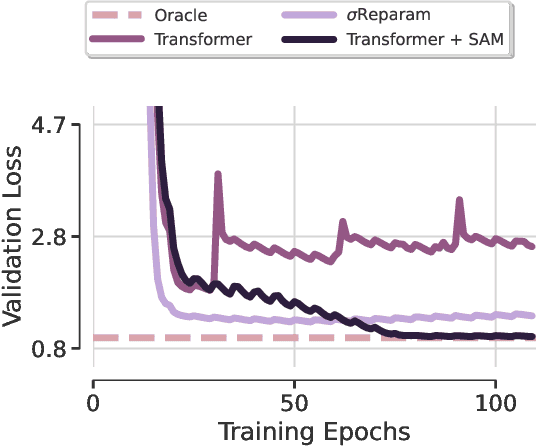
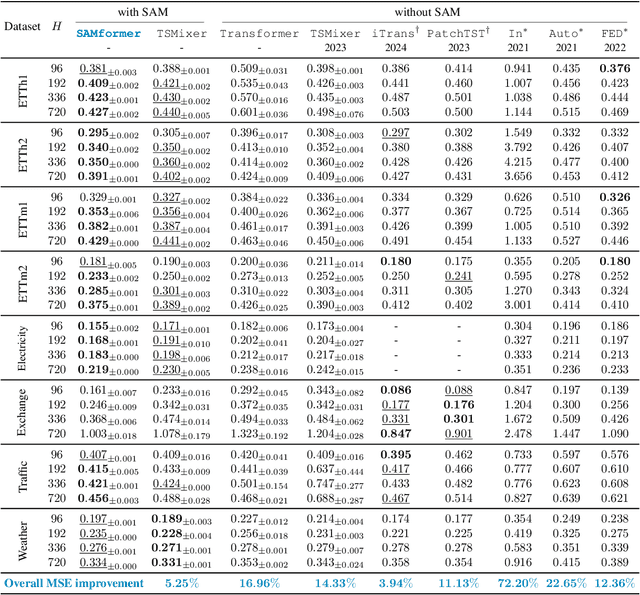
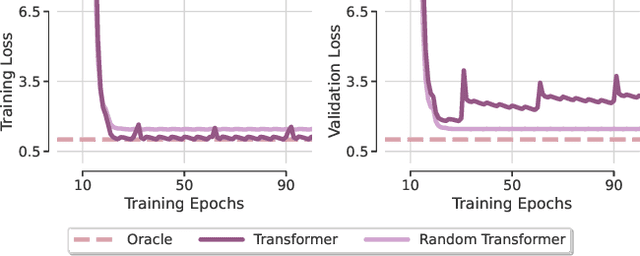
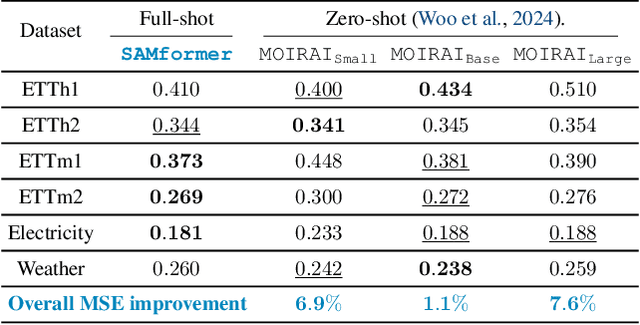
Abstract:Transformer-based architectures achieved breakthrough performance in natural language processing and computer vision, yet they remain inferior to simpler linear baselines in multivariate long-term forecasting. To better understand this phenomenon, we start by studying a toy linear forecasting problem for which we show that transformers are incapable of converging to their true solution despite their high expressive power. We further identify the attention of transformers as being responsible for this low generalization capacity. Building upon this insight, we propose a shallow lightweight transformer model that successfully escapes bad local minima when optimized with sharpness-aware optimization. We empirically demonstrate that this result extends to all commonly used real-world multivariate time series datasets. In particular, SAMformer surpasses the current state-of-the-art model TSMixer by 14.33% on average, while having ~4 times fewer parameters. The code is available at https://github.com/romilbert/samformer.
Characterising Gradients for Unsupervised Accuracy Estimation under Distribution Shift
Jan 17, 2024



Abstract:Estimating test accuracy without access to the ground-truth test labels under varying test environments is a challenging, yet extremely important problem in the safe deployment of machine learning algorithms. Existing works rely on the information from either the outputs or the extracted features of neural networks to formulate an estimation score correlating with the ground-truth test accuracy. In this paper, we investigate--both empirically and theoretically--how the information provided by the gradients can be predictive of the ground-truth test accuracy even under a distribution shift. Specifically, we use the norm of classification-layer gradients, backpropagated from the cross-entropy loss after only one gradient step over test data. Our key idea is that the model should be adjusted with a higher magnitude of gradients when it does not generalize to the test dataset with a distribution shift. We provide theoretical insights highlighting the main ingredients of such an approach ensuring its empirical success. Extensive experiments conducted on diverse distribution shifts and model structures demonstrate that our method significantly outperforms state-of-the-art algorithms.
Leveraging Ensemble Diversity for Robust Self-Training in the Presence of Sample Selection Bias
Oct 26, 2023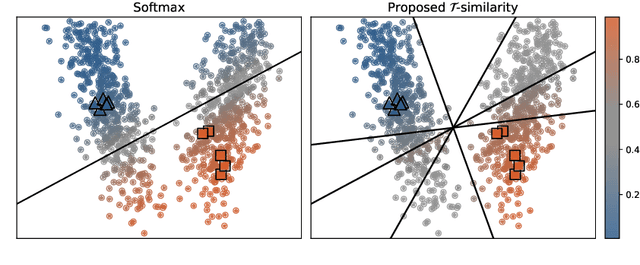
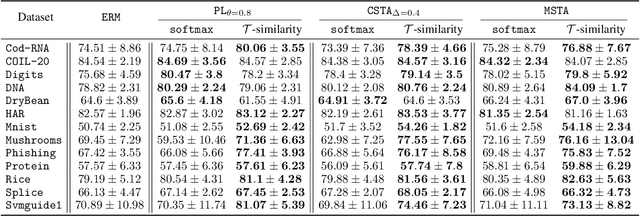
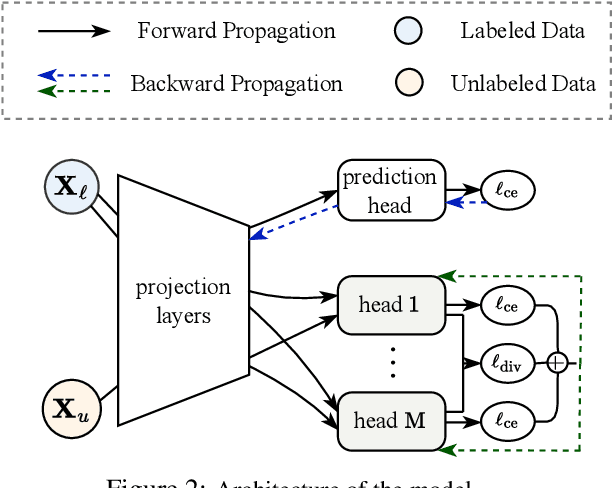
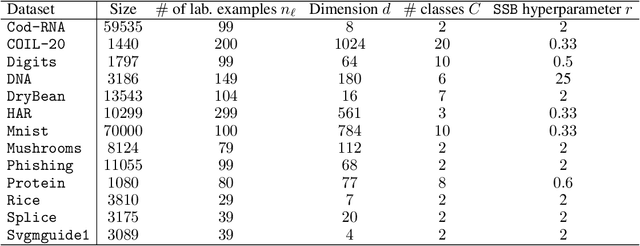
Abstract:Self-training is a well-known approach for semi-supervised learning. It consists of iteratively assigning pseudo-labels to unlabeled data for which the model is confident and treating them as labeled examples. For neural networks, softmax prediction probabilities are often used as a confidence measure, despite the fact that they are known to be overconfident, even for wrong predictions. This phenomenon is particularly intensified in the presence of sample selection bias, i.e., when data labeling is subject to some constraint. To address this issue, we propose a novel confidence measure, called $\mathcal{T}$-similarity, built upon the prediction diversity of an ensemble of linear classifiers. We provide the theoretical analysis of our approach by studying stationary points and describing the relationship between the diversity of the individual members and their performance. We empirically demonstrate the benefit of our confidence measure for three different pseudo-labeling policies on classification datasets of various data modalities.
Random Matrix Analysis to Balance between Supervised and Unsupervised Learning under the Low Density Separation Assumption
Oct 20, 2023



Abstract:We propose a theoretical framework to analyze semi-supervised classification under the low density separation assumption in a high-dimensional regime. In particular, we introduce QLDS, a linear classification model, where the low density separation assumption is implemented via quadratic margin maximization. The algorithm has an explicit solution with rich theoretical properties, and we show that particular cases of our algorithm are the least-square support vector machine in the supervised case, the spectral clustering in the fully unsupervised regime, and a class of semi-supervised graph-based approaches. As such, QLDS establishes a smooth bridge between these supervised and unsupervised learning methods. Using recent advances in the random matrix theory, we formally derive a theoretical evaluation of the classification error in the asymptotic regime. As an application, we derive a hyperparameter selection policy that finds the best balance between the supervised and the unsupervised terms of our learning criterion. Finally, we provide extensive illustrations of our framework, as well as an experimental study on several benchmarks to demonstrate that QLDS, while being computationally more efficient, improves over cross-validation for hyperparameter selection, indicating a high promise of the usage of random matrix theory for semi-supervised model selection.
 Add to Chrome
Add to Chrome Add to Firefox
Add to Firefox Add to Edge
Add to Edge